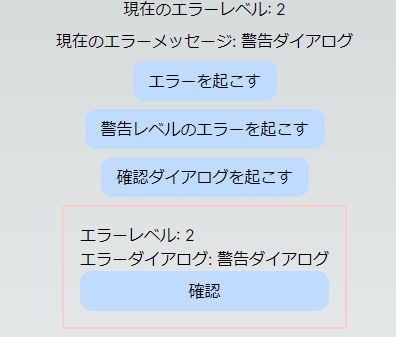エラーダイアログ表示サンプル
エラーログ管理のライブラリで良いのがあるかもだけど、なんだかんだ自分で書いた方が管理が楽なので書いたやつ。
(ライブラリの導入がほんと苦手で…)
githubレポジトリ
方針
- エラーメッセージは1つのファイルで管理する。コードの中に直接エラーメッセージを記述したくない。
- エラーダイアログ表示メソッドを集約し、ログ収集の必要が出た時に仕込みやすくする。
- DDDパターンとAtomic Designに基づくと、エラー状態管理のEntity層とダイアログコンポーネントのAtomsは共に上位なので、間をPresenter層で繋ぐ。
ディレクトリ構成
DDDパターン, Atomic Designを元にディレクトリを構成。
.
├── src
│ ├── components
│ │ ├── atoms
│ │ │ └── modal.tsx
│ │ └── dialog
│ │ ├── index.tsx
│ │ ├── presenters.tsx
│ │ └── views.tsx
│ ├── constants
│ │ └── msgcode.ts
│ ├── domains
│ │ ├── entities
│ │ │ └── sys
│ │ │ └── msg.ts
│ │ └── usecases
│ │ └── manage-error.ts
│ └── pages
│ ├── _app.tsx
│ └── index.tsx
└── ...
DDDパターン、そしてPresentation層ではMVPパターンを採用しています。
componentsディレクトリ内では、atomsとmoleculesのみAtomic Designを採用し、organismsより下位のコンポーネントはドメイン単位で区切る事にしています。
このあたりの設計に関しては、別途書きたいと思います。
定数宣言ファイルでエラーコードとメッセージを一括管理する。
エラーコードに対応するエラーメッセージと、そのエラーのレベルを設定します。
1つの変数に対して2つの値を返すので、辞書型で値を保持し、keyをエラーコードにして宣言します。
export const enum MSG_CODE {
API = 0x10000, // API関連
API_ERROR = 0x10001,
APP = 0x20000, // アプリ関連
APP_WARNING = 0x20001, // 警告
APP_INFO = 0x20002, // 確認
}
// メッセージレベル
export const enum MSG_LEVEL {
None = 0, // メッセージ解除
Info = 1, // 情報表示メッセージ
Warning = 2, // 警告メッセージ
Error = 3, // エラーメッセージ
}
// メッセージのレベルとテキストを指定する型、この型でメッセージを通知する。
export type MsgInfo = {
level: MSG_LEVEL;
message: string;
};
// これは公開しない
const messageDict: Record<MSG_CODE, MsgInfo> = {
[MSG_CODE.API]: { level: MSG_LEVEL.None, message: 'APIエラー' },
[MSG_CODE.API_ERROR]: { level: MSG_LEVEL.Error, message: 'APIエラーダイアログ' },
[MSG_CODE.APP]: { level: MSG_LEVEL.None, message: 'APPエラー' },
[MSG_CODE.APP_WARNING]: { level: MSG_LEVEL.Warning, message: '警告ダイアログ' },
[MSG_CODE.APP_INFO]: { level: MSG_LEVEL.Info, message: '確認ダイアログ' },
};
/**
* エラーコードをエラーレベルとメッセージに変換する関数
* @param code
* @returns msgInfo
*/
export const getMessageByCode = (code: MSG_CODE): MsgInfo => {
const msgInfo = messageDict[code];
return msgInfo;
};
今回の例では、確認ダイアログ表示もここに含んでしまっています。
なのでエラーコードというよりメッセージコードなので、命名にちょっと問題アリですが、例えば
- 不具合が発生し動作を停止したいレベル
- 不具合が発生しているが、動作は止めないレベル
- 動作上問題はないが、何らかの不具合が起きる可能性を示すレベル
などで分類するとよいかもしれません。
React(Next.js)のようにSPAだとネットワーク接続がなくても動かせてしまうと思うので、ネットワークエラーの間はMSG_LEVEL.NetworkErrorレベルを保持しておいて、画面右端にダイアログを表示し続けるとか。
RxJSライブラリを用いてエラー状態管理とイベント発行を行う。
「エラー状態管理」と銘打っているので、これはEntity層に入れてしまいます。
エラー状態になったらダイアログコンポーネントを表示するようにしたいですが、Next.js(React)はPresentation層のフレームワークとして扱うため、Domain層からPresentation層へ依存する事ができません。
そこで、RxJSを用いてイベントを発行し、React(Next.js)でイベントを購読するようにします。
/**
* エラー状態管理ステートクラス
*/
export default class MsgState {
private static _instance: MsgState;
private _msgInfo: MsgInfo;
public msgInfoAsObservable: BehaviorSubject<MsgInfo>;
constructor() {
this._msgInfo = getMessageByCode(MSG_CODE.DEFAULT);
this.msgInfoAsObservable = new BehaviorSubject<MsgInfo>(this._msgInfo);
}
public static get instance() {
if (!this._instance) {
this._instance = new MsgState();
}
return this._instance;
}
public setMessage(code: MSG_CODE) {
let msgInfo = getMessageByCode(code);
if (msgInfo === undefined) {
msgInfo = getMessageByCode(MSG_CODE.DEFAULT);
}
this._msgInfo = msgInfo;
this.msgInfoAsObservable.next(msgInfo);
}
public clear() {
const msgInfo = getMessageByCode(MSG_CODE.DEFAULT);
this._msgInfo = msgInfo;
this.msgInfoAsObservable.next(msgInfo);
}
}
これをPresentation層であるダイアログコンポーネントのPresenterで購読します。
/**
* @package
* @returns
*/
export const MsgDialogPresenter = () => {
const [msgInfo, setMsgInfo] = useState<MsgInfo>()
useEffect(() => {
const subscriber = msgInfoAsObservable.subscribe((_) => { setMsgInfo(_) });
// コンポーネント破棄時にイベントリスナー破棄
return () => subscriber.unsubscribe();
}, []);
return (<>
{msgInfo && msgInfo?.level !== MSG_LEVEL.None && (
<MsgDialogView msgInfo={msgInfo} okCallback={() => confirm()} />
)}
</>)
}
デモ
では試しに動かしてみます。
export default function Home() {
const [msgInfo, setMsgInfo] = useState<MsgInfo>()
useEffect(() => {
const subscriber = msgInfoAsObservable.subscribe((_) => { setMsgInfo(_) });
// コンポーネント破棄時にイベントリスナー破棄
return () => subscriber.unsubscribe();
}, []);
const buttonCss = "bg-blue-200 rounded-xl px-4 py-2"
return (
<main
className={`flex min-h-screen flex-col items-center gap-2`}
>
<p>現在のエラーレベル: {msgInfo && msgInfo.level}</p>
<p>現在のエラーメッセージ: {msgInfo && msgInfo.message}</p>
<button className={buttonCss} onClick={() => setError()}>エラーを起こす</button>
<button className={buttonCss} onClick={() => setWarning()}>警告レベルのエラーを起こす</button>
<button className={buttonCss} onClick={() => setInfo()}>確認ダイアログを起こす</button>
<MsgDialogPresenter />
</main>
)
}
メモ
- どのレイヤーでtry..catchでエラーハンドリングをすべきなのか?
個人的にはusecase層だと思います。entities層(model層?)への依存は基本的にはusecase層からなので。
あとがき
RxJSを使わなくてもReduxで同じ事ができるので、細かい事を考えないならReduxなのかなと思ってしまいます。
もしくはライブラリを探せば。


